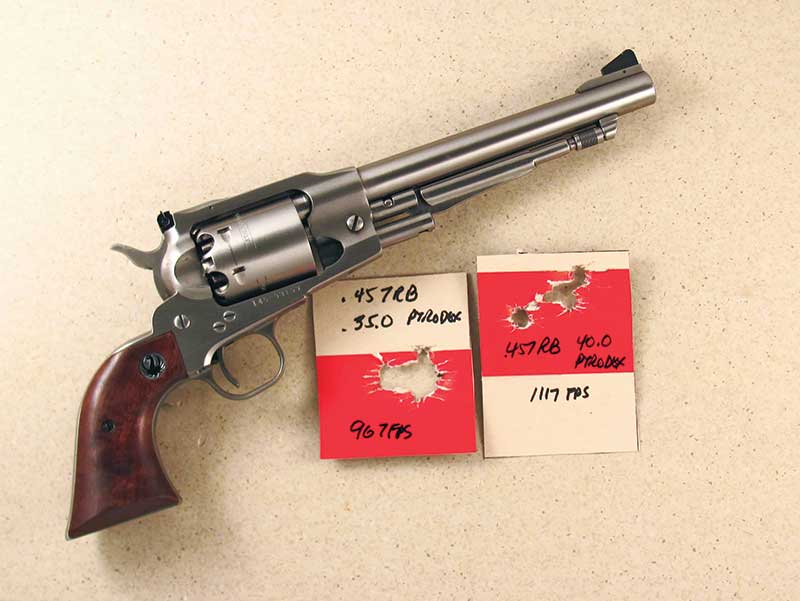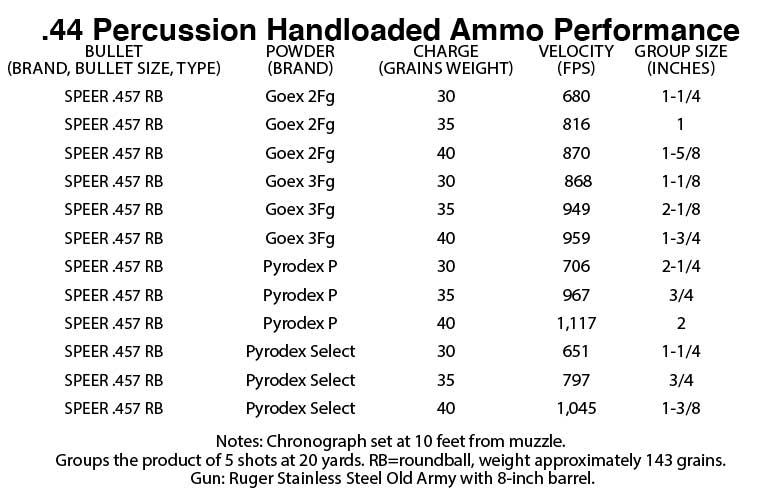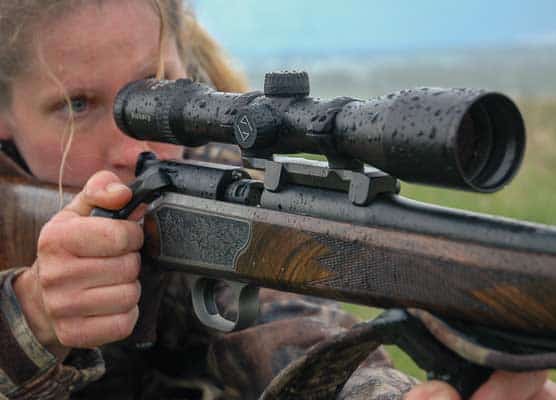Reloading The Original Way
Cap ’n’ ball shooting with Ruger’s Old Army .44
All cap ’n’ ball sixguns, whether they be replicas of original Remingtons and Colts or the more modern Ruger Old Army, operate the same way. The powder charge is placed in the cylinder chamber, a wad is placed over the powder if desired, and an over-sized roundball is seated using the built in rammer under the barrel. That’s the simple outline.
Before any percussion pistol is loaded, and especially after it has been stored in an oiled condition, percussion caps should be placed on each nipple and fired to clear the charge holes. Again this is before loading. If you don’t, there is a good chance the loading will push oil into the nipple charge hole and the gun will not fire. Angle the muzzle near the ground pointing downrange and pop the cap alone. A puff of dust near the muzzle is a pretty good indication the nipples are clear.
Powder is poured from a powder measure into each chamber. I find the see-through powder flask and adjustable powder measure from Thompson/Center to be invaluable for this operation. The clear plastic may not be traditional but it certainly is handy. I also use brass powder flasks each of which is marked with the powder it holds as well as the amount it throws, however I still pour the powder into the powder measure.
By pouring the powder into the powder measure first, there is no chance of an ember setting off the entire powder flask. Once the charge has been placed in the chamber, a lubed wad is then pushed into the front of the chamber by hand. A roundball is then set over the wad, the cylinder rotated under the rammer and the ball seated solidly compressing powder and wad in the process. I then leave the rammer in the front of the chamber as it holds everything just right while I place the next powder charge, wad, and bullet.
Seal The Chambers
The use of the lubed wads provides lubricant for the barrel, helps reduce fouling, and most importantly, seals each chamber against the flash from the discharge setting off the next chamber or multiple chambers as well. Without sealing the chambers, it is possible for two or even three chambers to ignite nearly at once with one ball going down the barrel and the others coming from the front of the cylinder alongside the frame.
I prefer to use both wad and lubricant. This helps keep the powder fouling soft and the barrel clean(er). I top off each chamber with something as cheap as Crisco using a “cake-decorator” type applicator or the more modern T/C Bore Butter. Once every chamber has been greased, then—and only then—are the percussion caps placed on all nipples with the sixgun pointing safely downrange. It is easy to see why as the gun faces you as you’re loading.
With maximum loads, there’s no room left in the chamber for a wad. In this case, the front of each chamber must be sealed with grease. Bore Butter is a lot less messy than the old standby Crisco, however Crisco is cheaper. And let me reiterate: then and only then are caps placed on the nipples. If the caps aren’t tight they will fall off during discharge. They must be a press fit on the nipple, or slightly squeezed to fit properly. I keep both Speer No. 11 and No. 10 caps in my shooting box. A too-loose fired cap has a tendency to fall into the action exposed by a cocked hammer.
In addition to black powder I also use Pyrodex. My somewhat standard loads are 30 to 40 grains by volume measure not by weight. Black powder measures are marked in 5-grain graduations to make measuring easy.
Trying to hold the Old Army in the hands while reloading is a cumbersome task. A loading block can be easily crafted out of 3/4×6-inch pine using two pieces screwed together in the shape of an “L.” The upright should be approximately 10 inches while the horizontal piece around 6 inches. Two more smaller pieces are needed. One, approximately 1-1/2 inches is screwed to the upright with a cut out to hold the barrel while another 2-1/2-inch wide piece notched in the center to hold the butt is screwed to the front of the bottom piece. With the sixgun placed in the loading block, your hands are free for the necessary loading steps.
Some shooters shy away from these guns because they perceive them too messy and hard to clean. I clean the very cheap way while shooting by using a spray bottle of Windex. After every cylinder full I run a patch down the barrel soaked with Windex and also spray Windex on the outside of the revolver and wipe it off with a rag. When I am finished shooting I switched to a spray bottle of black powder cleaner swabbing out the barrel several times and squirting plenty of solvent into the cylinder, letting it soak. For serious cleaning I use the same spray cleaner along with patches, a rag, and especially Q-Tips to reach in all the hard to get places.
I don’t totally strip down the gun every time I shoot, however, I do once every couple of times and clean all the action parts. The Ruger Old Army is relatively easy to take apart and put back together if you pay attention. I have literally no mechanical ability, so if I can do it anyone can.
I don’t know if percussion caps are made different than they were 45 years ago when I first started shooting the Old Army, but this past year I had some problems with ignition. Sometimes it would take two or three strikes on a percussion cap to get it to go off. I solved this by replacing all the nipples on my Old Army sixguns with Slix-Shot brand stainless steel nipples. They are not cheap costing about $35 per 6. However, they not only solve the ignition problem they are vented on the side which helps prevent portions of fired caps from falling down into the action and tying up the gun or jamming between the back of the cylinder and the frame. I found them at Long Hunter Shooting Supply, which provides very fast service. Each bag of six nipples I received was marked for use with No. 10 caps. I have no idea whose No. 10 caps they are using, as none of mine would fit and it was necessary to use No. 11 caps. I prefer Speer Magnum percussion caps when available, and if not Speer regular caps.
The Ruger Old Army uses 0.457-inch roundballs and both Speer and Hornady give excellent results. Roundballs are usually sold in three diameters for the .44 percussion revolvers, namely 0.451, 0.454, and 0.457 inch. The smaller balls will not seat tightly in the Ruger chambers and the 0.454-inch may also work their way out of the cylinder. The 0.457-inch roundballs are tight requiring some pressure to seat. When the roundball used cuts a ring of lead as it is seated we have the right diameter.
We have many choices for powder. No smokeless need apply, but there is a long list of both black powder and black powder substitutes. I have tried just about everything over the years and settled on Hodgdon Pyrodex or Goex black powder. The local black powder club stocks Goex in its many granulations while most well-stocked gun stores carry Pyrodex. I have pretty much settled on Goex FFg or FFFg and Pyrodex P. The purists among us consider nothing but black powder, however we crossed Pure Street when we picked the modern Old Army over replicas of original Colt or Remington cap-and-ball sixguns, so I see no problem whatsoever mating up the Old Army with Pyrodex. Pyrodex is cleaner to use and also easier to clean up after.
Hunting Loads
As for hunting, consider this: the roundball weighs approximately 140 grains and achieves somewhere from 950 to 1,100 fps max depending upon the powder. A +P .38 Special uses a 158-grain bullet in this velocity range. Should the .38 Special be used for anything larger than very small game? The Old Army can be improved for hunting by using a conical bullet of around 220 grains, but velocity will be less. If you seriously contemplate using the Old Army for hunting, it would be better if converted to a 5-shot .51 sixgun by someone such as Gary Reeder.
I shoot a lot of percussion sixguns, but nowhere near as much as I shoot cartridge revolvers. However, I find it very relaxing to spend a day shooting the Old Army. Without hurrying, it takes me just about 8 minutes from start to finish to load and fire a cylinder full of roundballs. The time required alone causes me to relax. Add the lack of punishing recoil and excellent accuracy and the day is very pleasant.
Ruger stopped production of the Old Army nearly 10 years ago and I doubt we will ever see it again. They still show up infrequently at gun shops and still at relatively reasonable prices. While the loads here are for the Ruger, the techniques are applicable to all cap-and-ball revolvers.





